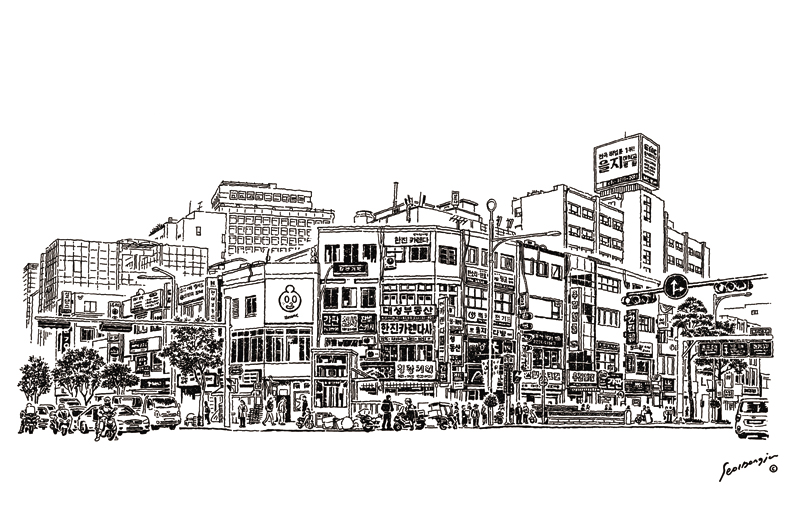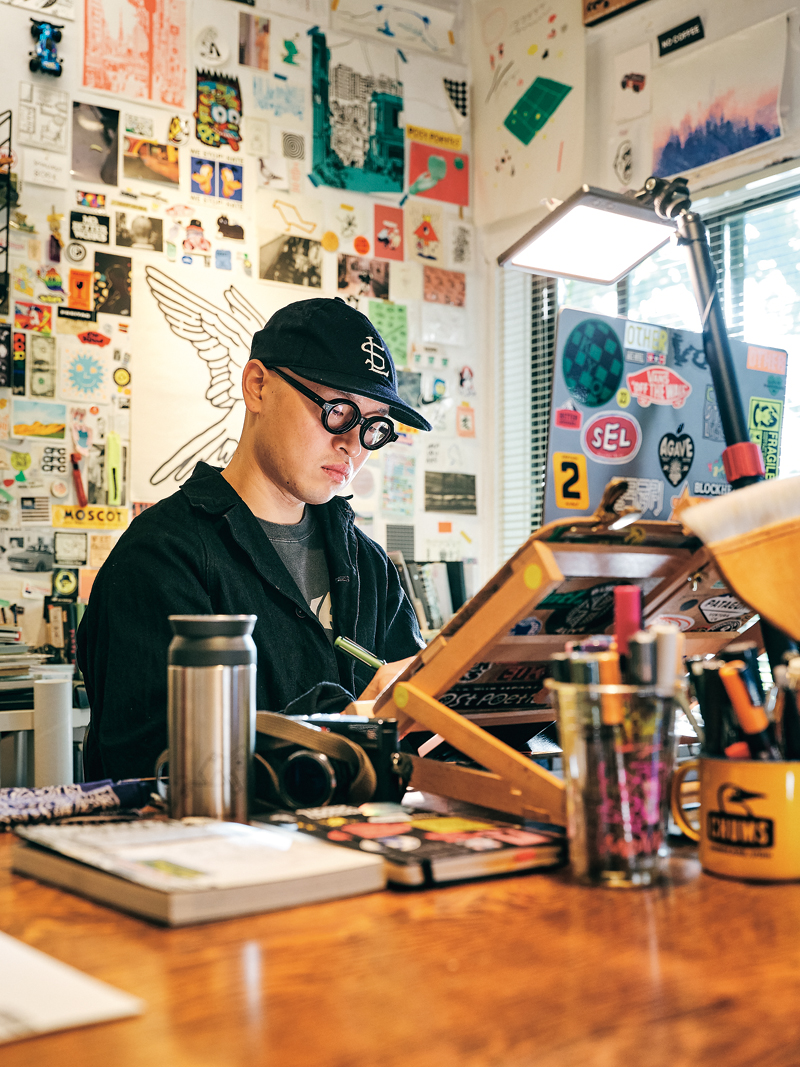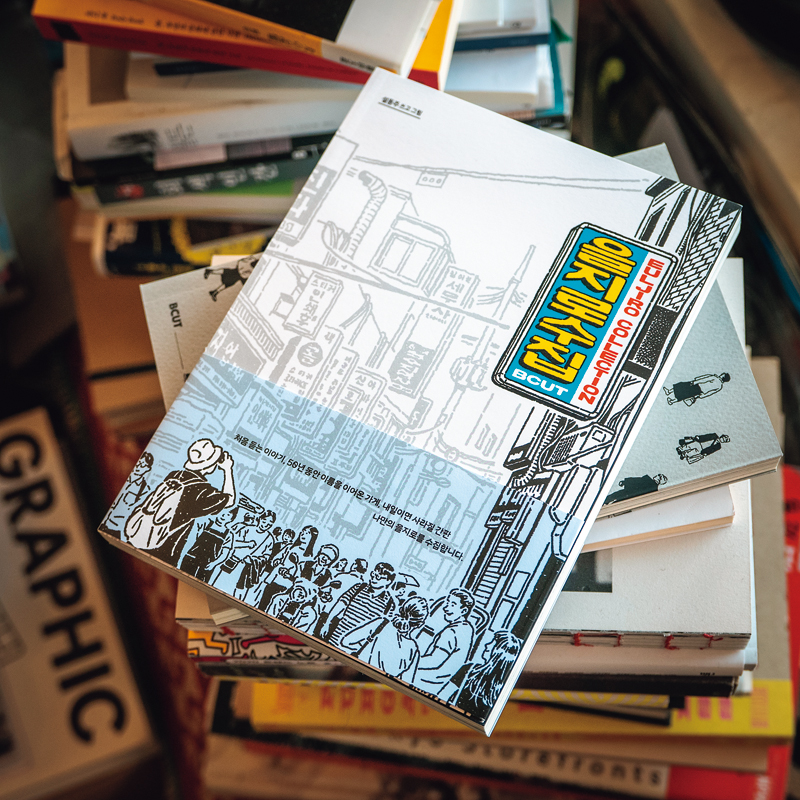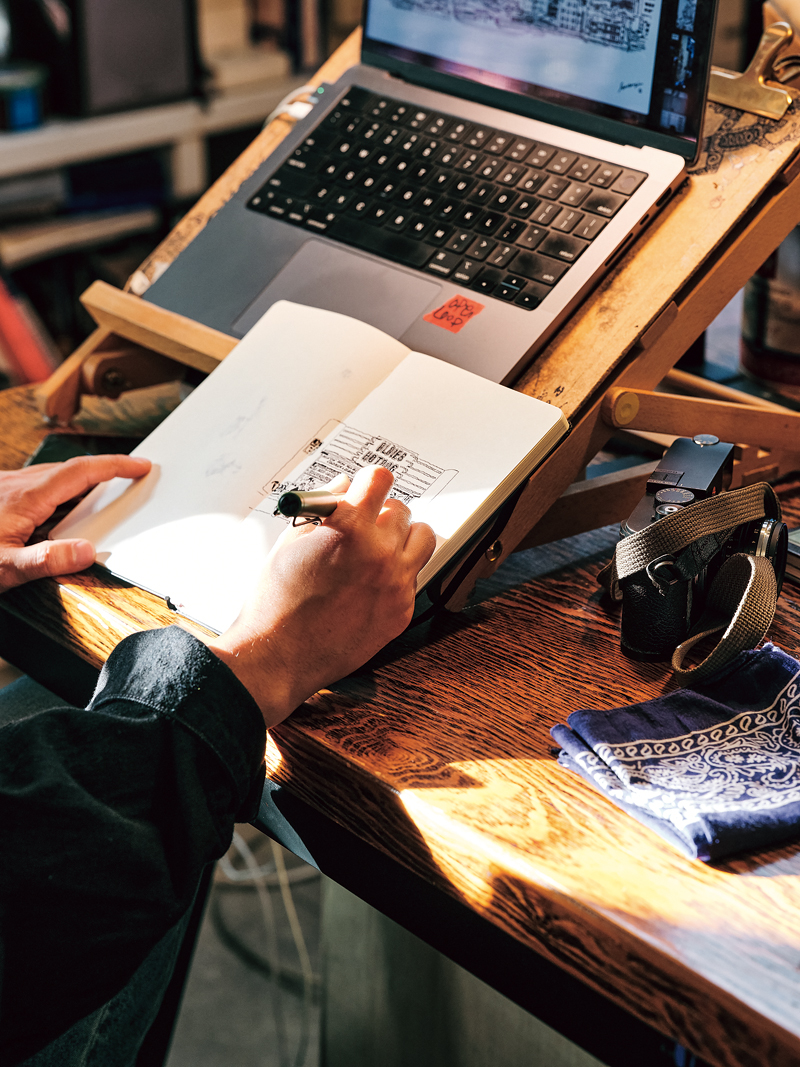설동주(Seol Dong-ju, 薛棟柱)는 사진과 펜 드로잉으로 도시를 기록하는 일러스트레이터이다. 그는 여행지에서 마주친 풍경과 사람들을 정감 어린 필치의 드로잉으로 표현한다. 2020년 발간한 『을지로 수집』에는 자신만의 시선과 감성으로 포착한 을지로의 단면들이 담겨 있다.
Illustrator Seol Dong-ju documents cities through photographs and drawings, recording people and places with endearing pen strokes. His 2020 book Euljiro Collection depicts the eponymous neighborhood from a personal perspective that reflects his deep attachment to the area.

서울역 근처에 자리한 설동주의 작업실에 들어서면 고딕체로 된 스텐실 도안이 가장 먼저 눈에 띈다. “We live City We love.”라는 문구는 그가 머무르는 공간과 아주 잘 어울린다. ‘도시’와 ‘사랑’은 그의 작업을 규정하는 핵심적인 키워드들이기 때문이다.
The first thing that catches your eye when entering Seol Dong-ju’s studio near Seoul Station is a stencil design in a Gothic font. It reads “We Live City We love,” which points to the theme that defines Seol’s work: his love of cities.
“옛것이 주는 편안함에 반해 을지로를 자주 오갔다.”는 그는 그곳의 과거와 현재를 돌아보는 이미지들을 모아 몇 해 전 『을지로 수집』이라는 책을 펴냈다. 그가 ‘수집’한 이야기들은 이미 없어진 것들에 대한 향수를 불러일으키고, 조만간 사라질 처지에 놓인 것들에게 애틋함을 느끼게 한다. 이 책에는 옛것과 새것의 공존을 꿈꾸며 동네 특유의 문화를 계승 중인 청년들의 인터뷰도 실려 있다. 건강한 변화 덕분에 희망을 발견한다는 그가 을지로를 향한 오래된 애정을 고백했다.
“I visited Euljiro often, drawn in by the comfort that old things provide,” Seol explains. His book Euljiro Collection evokes nostalgia for bygone places and scenes before they disappear. Within is an assemblage of images and interviews with young people working to preserve Euljiro’s culture by merging old and new. The book also expresses the author’s longstanding affection for the area and his newfound hope for positive change.

책을 출간한 지 몇 년이 지났다. 그동안 독자들을 많이 만났나? How was the reaction to your book?
을지로에 대한 관심이 높아지면서 많은 분들이 내 책을 읽은 것 같다. 출판 후 새로운 사람들과 일할 수 있는 좋은 기회도 생겼다. 다만 발행 후에 북토크 같은 행사를 열고 싶었는데, 코로나19 팬데믹으로 인해 불발된 점이 내내 아쉬웠다.
Interest in Euljiro is high, and it seems that quite a few people have read it. After it was published, I was lucky to have the chance to work with fresh faces. I also wanted to hold an event such as a book talk, but unfortunately the COVID-19 pandemic disrupted those plans.
을지로를 기록하겠다는 생각은 어떻게 하게 됐나? What motivated you to document Euljiro?
내가 어렸을 때 살던 염리동(鹽里洞) 이야기부터 해야 할 것 같다. 나는 집들이 다닥다닥 붙어 있는 골목의 정취를 무척 좋아했고, 성장한 후에도 아름다운 기억으로 남았다. 한번은 친구에게 그 동네를 보여 주고 싶어 데려갔는데, 재개발로 인해서 철거가 시작되고 있었다. 너무 안타깝고, 원망스러웠다. 이곳에 대한 기록을 사진이나 그림으로 왜 남기지 않았을까 하는 생각이 불현듯 스쳤다.
I trace it back to my childhood in Yeomni-dong [in Seoul’s Mapo District]. I cherished the atmosphere of this neighborhood, with its houses clustered together in small alleys, and I fondly remember them to this day. Once, I took a friend to that part of town to show him around, but demolition had already begun for the neighborhood’s redevelopment. It was such a shame and I felt devastated. I blamed myself for not having created any record of the area, either in photos or drawings.
그러다가 2017년인가 2018년쯤 을지로도 비슷한 상황이라는 소식을 들었다. 을지로도 예전부터 자주 들락거렸던 동네인데, 이번만큼은 좋아하는 장소가 자취를 감추기 전에 나만의 방식으로 최대한 많은 모습을 남기고 싶었다. 그래서 헐리고 있는 건물이나 철거가 예정된 공간들을 기록하기 시작했다.
Time passed, and in 2017 or 2018, I heard a similar fate was awaiting Euljiro. I had regularly frequented the neighborhood, and this time around I wanted to preserve memories of it in my own special way before it vanished. So, I started documenting spaces being demolished or awaiting demolition.
책에는 을지로를 터전으로 살아가는 인물들의 인터뷰가 실려 있다. 그들의 반응은 어땠나? How did the Euljiro residents react to being interviewed?
책에 소개한 사람들 중에는 이전부터 알고 지내던 분들이 꽤 있다. 매체에 노출된 경험이 별로 없었기 때문에 자신들의 얼굴이 알려지게 된 걸 재밌어하고 신기해했다. 인터뷰이들 중에는 자의로 다른 동네에 이사 간 사람도 있고, 지내던 공간이 철거 대상으로 지정되는 바람에 어쩔 수 없이 자리를 옮긴 경우도 있다. 요즘도 을지로에 가면 책의 주인공들을 찾아가 안부를 묻곤 한다.
Many of them were longtime acquaintances. They had little experience with the media, so they were both amused and surprised that their stories would become known. Some of them had already moved to other areas of their own volition, while others had to move against their will because the spaces they occupied were designated for demolition. When I visit Euljiro these days, I always say hello to those who are still around.

인터뷰이들은 어떤 기준으로 선정했나? How did you choose the content for your book?
풍년이용원은 토박이들도 내력을 잘 모를 정도로 오래된 이발소인데, 주인이 여러 번 바뀌었어도 상호와 간판이 그대로 유지되고 있다. 에이스포클럽(Ace Four Club)은 60년 된 다방을 개조한 카페 겸 바이다. 나는 을지로에 오래 계셨던 분들이나 본인 의지로 새로이 터를 잡은 분들을 두루두루 만나보고 싶었다. 다양한 분야에 종사하는 분들을 깊이 있게 인터뷰하자는 목표도 세웠다. 그래야 이곳의 폭넓은 스펙트럼을 제대로 보여 줄 수 있을 것 같았다.
Pungnyeon Barber Shop is very old and even the locals aren’t sure of its history. The shop has changed hands several times over the years, but the name and sign still remain. Ace Four Club is a café and bar in a renovated tearoom dating back to the 1960s. I wanted to meet newcomers as well as people who had lived and worked in Euljiro for a long time. I also made it my goal to do in-depth interviews with people working in different fields. Only then would I be able to illustrate the wide spectrum of this place.
최근 몇 년 사이 을지로가 핫플레이스로 부상했다. 책에서 당신의 염려를 느낄 수 있었다.
원고를 쓸 때만 해도 나는 당시 을지로에서 감지되는 변화의 바람을 다소 부정적으로 바라봤다. 그런데 지금은 오히려 달라진 모습이 예뻐 보이기도 한다. 젊은이들이 많이 드나들면서 상권이 활발해지는 것도 바람직하다. 옛것을 포용하면서도 새로운 활력을 받아들이는 상생이 이뤄지고 있는 것 같아 희망을 느꼈다.
How has your perspective changed?
When I was writing the book, I was a bit skeptical about the winds of change blowing in Euljiro. But now I think the transformation is appealing. It’s good that commerce is flourishing and attracting younger visitors. I’ve grown hopeful about embracing the old and inviting new vitality.
그런가 하면 기존 을지로와 너무나 이질적인 모습을 발견할 때는 ‘이게 뭐지?’ 싶기도 하다. 마음이 오락가락한다. 그래서 다시 책 작업을 한다면 무척 다른 결과물이 나올 것 같다. At the same time, when I see something completely at odds with what Euljiro used to look like, I stop and say to myself, “What is this?” My mind is fickle. I think if I were to write the book again, it might turn out quite different.
지금 이 책에 그림 몇 장을 추가한다면 무엇을 그리고 싶나? Could you give an example?
예전에는 세운상가 옥상에 올라가면 청계천부터 남산타워까지 한눈에 조망할 수 있었다. 지금은 주변에 신축 건물들이 생겨나서 풍경이 달라졌다. 내가 좋아했던 모습을 다시는 볼 수 없게 되어 아쉽지만, 달라진 전경(全景)을 그려 보고 싶기도 하다.
Up until a while ago, the rooftop of Sewoon Plaza offered an unobstructed view from Cheonggyecheon to Namsan Tower. But the view has changed because new buildings went up in the vicinity. It’s a pity I can no longer enjoy the old cityscape I was fond of, but I want to try drawing the new one as it is.

그림 속 등장인물들과 장면들을 선정하는 기준이 궁금하다. What inspires the scenes you draw?
군중 속에서 개인 개인을 발견하는 재미가 있고, 저마다 사연이 있을 것 같다는 말을 자주 듣는다. 노가리 골목 그림 같은 것이 그렇다. 연령도, 차림새도, 직업도 다른 수많은 사람들이 똑같은 음식을 먹고 있는 모습이 재밌지 않나? 그림을 자세히 들여다보면 데이트하러 온 연인, 여행 온 외국인 등 여러 인물들을 발견할 수 있다. 내 캐릭터도 살짝 숨겨 뒀다.
It’s fun discovering individuals in the crowd, and people often tell me that each character appears to have their own story. My drawing of Nogari Alley is a good example. Isn’t it interesting to see so many people of different ages and occupations dressed all differently but all eating the same food? If you look closely at the drawing, you’ll notice things like couples on a date and foreign tourists. I even hid a self-portrait somewhere in there too.
펜 드로잉을 처음 시작할 때는 누가 봐도 예쁘고 멋진 풍경을 그리고 싶었다. 그런데 차츰 독자들이 다층적 감정을 느끼면 좋겠다는 욕심이 생기더라. 그래서 풍경 속 사람들의 모습을 어떻게 표현하면 좋을지 늘 세심히 신경 쓰며 작업한다. 사람을 몇 명 등장시킬지, 어디에 배치할지는 그때그때 다르다.
When I started out with pen drawings, I wanted to draw breathtaking cityscapes. But gradually, I wanted the people who saw my drawings to feel complex emotions. I think carefully about how to depict people in my cityscapes. How many I add and where I place them differs in every drawing.
자신의 정체성을 ‘시티 트레커(city trekker)’로 규정하는 이유는 무엇인가? Why do you call yourself a “city trekker”?
을지로를 비롯해 뉴욕, 도쿄, 후쿠오카 등을 그렸다. 그리고 어려서부터 파리에 대한 동경이 있었는데, 빠른 시일 내에 그곳을 그림과 사진으로 담아보고 싶다. 나는 도시 곳곳을 여행하면서 소소하게 마주치는 찰나의 감성을 포착한다. 도시의 풍경, 그중에서도 일상의 사소한 순간들이 바로 우리 자신의 이야기이고 그것들이 모여 삶을 이루는 게 아닐까?
I’ve drawn Euljiro, New York, Tokyo, and Fukuoka, among other cities. I’ve admired Paris since I was a child and want to draw and photograph the city as soon as I get the chance. Traveling through cities, I capture the essence of everyday moments. The cityscape and those ordinary moments tell our stories and shape our lives.
마지막으로 하고 싶은 말은? Any final comments?
을지로를 방문하려는 분들에게 동대문, 종로, 충무로 등 주변 동네들도 거닐어 보기를 권한다. 모두 매력적인 곳들이다. For those interested in Euljiro, I recommend exploring nearby areas such as Dongdaemun, Jongno, and Chungmuro. They each have their own charm and interesting atmosphere.
남선우(Nam Sun-woo, 南璇佑) 『씨네21』 기자
허동욱 포토그래퍼
Nam Sun-woo Reporter, CINE21
Heo Dong-wuk Photographer
